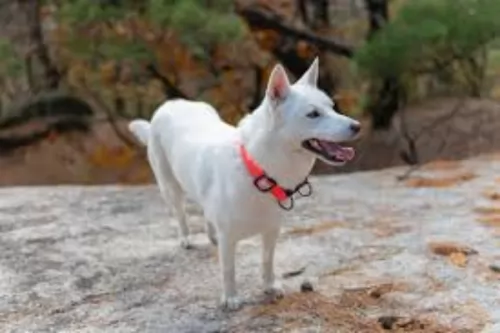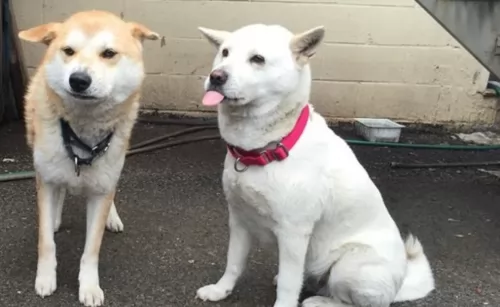 Petzlover
PetzloverJindo is originated from South Korea but Nebolish Mastiff is originated from Canada. Jindo may grow 29 cm / 12 inches higher than Nebolish Mastiff. Jindo may weigh 177 kg / 390 pounds lesser than Nebolish Mastiff. Both Jindo and Nebolish Mastiff has almost same life span. Both Jindo and Nebolish Mastiff has almost same litter size. Jindo requires Moderate Maintenance. But Nebolish Mastiff requires Low Maintenance
 Hailing from Korea, the Jindo dog's name is actually taken from the island Jindo. The dogs lived on the island for thousands of years, developing into a natural breed with good hunting skills.
Hailing from Korea, the Jindo dog's name is actually taken from the island Jindo. The dogs lived on the island for thousands of years, developing into a natural breed with good hunting skills.
They are also known as Jin Dog, Jindo-kae or Jindo-kyon. The exact origins of the Korean Jindo are unknown and it is believed to have been developed from different Mongolian breeds.
They were brought to the United States and been entered into the American Kennel Club.
With the Mastiff breeds, the rarest and the smallest is the Nebolish Mastiff. Bred to be more agile than the giant mastiffs, the Nebolish was developed in Canada. They were developed by crossing several breeds, such as the English Mastiff, Neapolitan Mastiff, Dogue de Bordeux, Bull Terrier, Bullmastiff, Boxer, St. Bernard, and Deutsche Dogge. Perhaps there was some Great Dane as well. It was also hoped that they would have better health than the rest of the Mastiff breeds.
There are also those who believe the Nebolish Mastiff is not a Canadian crossbreed but rather the re-creation of the giant dogs that lived with the soldiers of Alexander the Great. Still others believe the breed is still being developed and no standard is yet true. They believe the dog is a hybrid. No one knows the exact breeding lines today and not many are breeding the Nebolish today. Thus, the dog is extremely rare.
Only the American Breeder Association (ABA), the Canada Molosser Association (CMA) and the Dog Registry of America Inc. (DRA) recognize the Nebolish Mastiff as a separate breed.
These dogs are courageous, loyal and dignified like all Mastiffs. They are protective of their families or their flocks. They are loving, intelligent and even-tempered. They are known to be great with kids since they are patient and calm – easy to train.
 The Jindo is a medium sized spitz-type dog breed which is well-proportioned with erect ears and a long tail which is held over the dog's back.
The Jindo is a medium sized spitz-type dog breed which is well-proportioned with erect ears and a long tail which is held over the dog's back.
He stands at roughly 45 – 65cm and they weigh anything between 11 to 23kg. The coat of the dog is medium length and available in a number of colors – yellow, tan, red, white, brindle, black or bi-color such as black and tan.
When you look at the Jindo you get the impression of bright alertness and intelligence. He makes a great watchdog, and with his bright, alert eyes and upright ears, he just looks like he is on guard.
The Jindo has always been a hunting dog so he has learned to be bold, tenacious and alert. He is also brave, courageous, loving and loyal to his master, but you need to know that he is a dominant dog who will get on well with an owner who is fair, strong, patient, kind and firm.
These dogs are strong willed, independent and dominant as well as being intelligent. He will require socialization and training from an early age. Be fair, firm and consistent with your instructions which he will obey once he has been trained. With training he gets on well with children in the home but he is inclined to have some difficulty with accepting other dogs into the family.
As with any dog breed, the temperament of the Jindo will vary according to the environment he lives in and the type of owners he has. The typical Jindo is an affectionate dog with his human family, being a little bit reserved around strangers.
The Nebolish Mastiff is very much like all other mastiffs with the exception of height and weight. He has a large head, long legs, strong neck, oval shaped paws, wide chest and large bones. He has solid muscles, large ears and a wide snout. They usually weigh anywhere between 43 and 82 kg. They tend not to slobber like the other mastiff breeds as a result of their breeding. They have a black mask and tail may or may not be docked.
 The Jindo makes an awesome pet for owners who enjoy an active lifestyle. A happy, contented Jindo becomes a devoted, loyal pet who wants to guard and protect his owner from strangers, for whom he is wary and reserved.
The Jindo makes an awesome pet for owners who enjoy an active lifestyle. A happy, contented Jindo becomes a devoted, loyal pet who wants to guard and protect his owner from strangers, for whom he is wary and reserved.
He is an intelligent pet too, being easy to train and socialize and while independent, he loves to spend time with his human family and is an all-round excellent pet.
Yes, they are very good with children.
Agility and swimming
No – they don’t do well with apartments and small spaces. They need a large fenced in yard.
High but can be stubborn
 The Korean Jindo dog is looked upon as a generally healthy dog breed with no serious genetic problems to talk about. Look out for eye diseases and dental decay as well as hypothyroidism, a common disease in dogs where you notice deterioration with the coat – thinning, dry and dull.
The Korean Jindo dog is looked upon as a generally healthy dog breed with no serious genetic problems to talk about. Look out for eye diseases and dental decay as well as hypothyroidism, a common disease in dogs where you notice deterioration with the coat – thinning, dry and dull.
The dog’s skin also becomes flaky and you’ll notice that your once energetic pet is now gaining weight and is lethargic. Get him to the vet. Hypothyroidism can be treated simply by your vet to get your pet healthy once again.
Bred to be much healthier than other mastiff breeds, the Nebolish has very few health concerns. They live twice as long as most other Mastiff and giant breeds at up to 14 years. The most often reported health issue is:
bloat – where the intestines and stomach organs are twisted or distended. Bloat can be deadly so don’t hesitate on treatment. Avoid it by not overfeeding after or before exercise.
Test for Hip dysplasia as it can cause lameness or arthritis.
 The Jindo has a double coat and this sheds heavily about twice a year, so certainly during these shedding periods you will need to brush his coat twice a week to keep it free from loose hair.
The Jindo has a double coat and this sheds heavily about twice a year, so certainly during these shedding periods you will need to brush his coat twice a week to keep it free from loose hair.
Never just assume that your dog is healthy and happy. When you brush him, check him over for ticks and fleas, check him for any unusual lumps, make sure his nose is wet and that his eyes are bright. Look at the condition of his fur, check his teeth and inside his ears – there are lots of tell-tale signs that can indicate that all is not well with your pet and then you need to get him to the vet.
As a medium-sized breed, if you feed your dog commercially manufactured food, he will require a high quality food that has been formulated for a dog of his size and his activity levels. Mix some home-made cooked chicken, brown rice or pasta as well as vegetables into his kibble and try to include some raw meat in occasionally too. He needs to always have access to fresh, clean water.
The Jindo is a high energy dog, and with his bright face you can tell that he is always ready for action. Long ago he was bred to perform hunting and retrieving type jobs, and with their stamina, they require having a busy day.
They certainly require a significant amount of exercise and mental stimulation, so you will need to include him in your daily walks and give him exciting ball games.
Don’t overfeed and don’t feed too much protein in the first year. Feed 1-2 cups in two meals.
bloat – Tendency to become obese so don’t over feed. About 2-3 cups in 2 meals per day.
agility and flexibility
This intelligent breed actually enjoys training, toys and all kinds of mentally stimulating puzzles. They love water and are very good swimmers. They need an average amount of exercise - a couple walks per day. Need a large fenced yard. They make great therapy dogs and play catch.